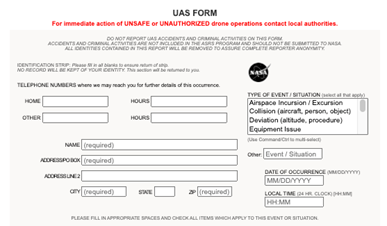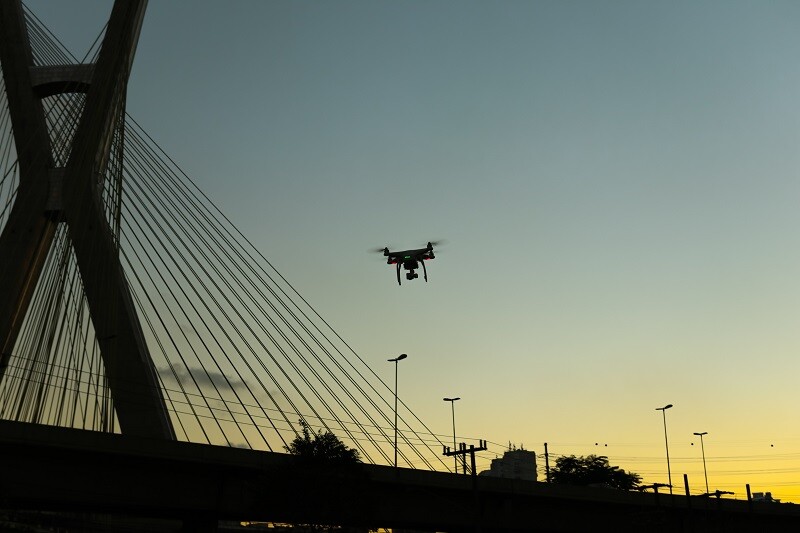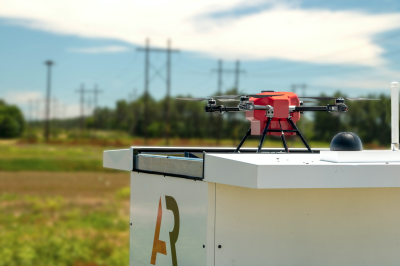Commercial drone operators can self-report incidents and accidents to NASA’s Aviation Safety Reporting System (ASRS). By taking part in the program, operators can actively contribute to a system that is collecting data on aerial operations and making the airways safer for all forms of aircraft. They can also take steps to enhance public perceptions around uncrewed aerial systems and further an overall culture of accountability and self-improvement.
“Every UAS operator, commercial or recreational, should be routinely using the ASRS to report incidents or near-misses with the goal of raising the safety bar in the industry as a whole,” Ken Kranz, Chief Technology Officer at Cognizant Technology Solution’s UAS Team, told Commercial UAV News. A multinational, Fortune 100 technology services company helping customer engineer modern businesses, providing digital transformation services for their operations, Cognizant has been a leading advocate and technology sponsor for the emerging UAV industry since the early 2010s.
How the ASRS works
ASRS encourages all aviation professionals, including pilots, mechanics, ground personnel, and others, to submit reports to the ASRS “when they are involved in, or observe, an incident or situation in which aviation safety may have been compromised.” Information from the reports is entered into an incident database, which is used to identify trends that may lead to accidents and incidents, including pilot error, equipment failures, and more.
ASRS is a voluntary, confidential, and non-punitive reporting system. The system is administered by NASA, an independent third party that receives and de-identifies reports before sharing safety information. NASA never reveals the identity of the reporter or their company. In exchange for contributing valuable safety information, the FAA waives certificate action or civil penalty if the report is in scope of Advisory Circular 00-46F.
Integrating UAVs into the ASRS
The system, which was created in the mid-1970s, was only available to conventional aircraft professionals until 2021. Kranz was a member of a team of aviation professionals who advocated for including uncrewed systems in the ASRS. “I was invited to join the FAA’s Drone Safety Team, (formally the Unmanned Aviation Safety Team UAST) in its inception back in 2016, and I served on the Data Working Group for three years trying to identify data we could use to measure UAS safety,” he explained. “I was stymied by the sheer lack of data available for UAS incidents. Due to my manned aviation background, I knew of NASA’s Aviation Safety Reporting System (ASRS).”
Kranz researched what would be involved in developing an equivalent of the ASRS for drones. Eventually, he reached out to the NASA team to see if they would be interested in extending the ASRS to support unmanned operators.
“The NASA team under ASRS Director Becky Hooey was very interested in extending the ASRS for our needs,” Kranz stated. Working together, Hooey, Kranz, and their teams created the UAS section to the ASRS, which went into effect two years ago.
More drone reporting needed
Since then, the program has been successful in capturing information about uncrewed systems in our airspace, but many believe that more drone operators need to become aware of the system and get involved for the program to be truly valuable.
Fortunately, Hooey stated, more and more drone operators are learning about ASRS. “When manned aviation pilots go through training programs, the ASRS is integrated into the curriculum, but many drone pilots aren’t receiving that training, and they may not know about the program,” Hooey said. “But we have seen many drone training developers embracing the ASRS and including it into their curriculum for Part 107. So that's fantastic. And the more we can do that, the more we're going to get that awareness out and get more drone pilots to participate.”
More participation is crucial to the success of the program because it will help to create a more robust, comprehensive database that can be used to increase understanding and drive positive change in the drone industry. “It is important that all aviation incident data be housed in the same database,” Kranz asserted. “This is true because when an incident occurs, it can be reported by the UAS operator, manned operators, and ground crews. By having the data in the same database, these disparate reports can be linked together giving a better overall view of the incident.”
How to submit a report
Reporting is as simple as visiting the ASRS home page and then selecting “UAS” from the “Sub a Report” section. (The UAS form can be found here: https://asrs.arc.nasa.gov/uassafety.html)
A subsection of the submission form is shown below.

Enter as many of the fields that apply to your situation and hit submit. Once done, you will be presented with a unique reference number–which you should take care to save. It is important that you be as descriptive as possible in the narrative field. Any identifying information (your name, company, location, etc.) is expunged post submission.
Some early trends
Report submissions have created a large database that has revealed some useful information around drone accidents and incidents. “It may be a little bit too early to talk about ‘trends,’ but there are some interesting things that are popping up,” Hooey said. “For example, we’ve seen a few reports about batteries becoming dislodged during flight. Equipment issues and metal fatiguing have also turned up in reports.”
Another issue that ASRS reports have identified involves rules and regulations. “We’ve seen lot of confusion around where drone operators are allowed to fly, where they're not allowed to fly, and what authorizations they need? Also, sometimes, people think that if their drone has geofencing it will keep them out of controlled airspace, but that isn’t necessarily the case,” Hooey said.
Both Kranz and Hooey believe that increasing participation in the ASRS, building up the database, and using the accumulated information to foster safety and efficiency will help drone pilots improve their operations while increasing public comfort and acceptance with uncrewed systems.
“Sharing new information is the most important part of the ASRS,” Hooey stated. “Drone operators should know that reporting is not punitive, it is without consequences. The goal is to learn more about what is happening with drone accidents and incidents and make improvements.”















Comments